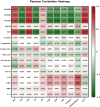Co-ensiling pomegranate (Punica granatum L.) peels and molasses with berseem (Trifolium alexandrinum L.) alters fermentation quality, nutrient composition, ruminal fermentation and methane production in buffalo bulls in-vitro
- PMID: 39779523
- PMCID: PMC11711153
- DOI: 10.1007/s11250-024-04259-6
Co-ensiling pomegranate (Punica granatum L.) peels and molasses with berseem (Trifolium alexandrinum L.) alters fermentation quality, nutrient composition, ruminal fermentation and methane production in buffalo bulls in-vitro
Abstract
Pomegranate peels are an industrial by-product high in sugar and phytochemical content and pose an environmental concern. Meanwhile, ensiling legume forage such as berseem is difficult due to its lower dry matter content and water-soluble carbohydrate-to-buffering capacity ratio, which leads to a poor fermentation process. To date, no studies have been conducted to investigate the effect of co-ensiling pomegranate peels with berseem. Thus, silage quality was evaluated after co-ensiling of berseem (control) with 50, 100, and 200 g/kg pomegranate peels or 50 g/kg molasses for 0, 15, 30, and 45 days (Experiment 1). Further, rumen nutrient degradation, methane production, and rumen fermentation parameters were evaluated in vitro (Experiment 2). Pomegranate peels (200 g/kg) and molasses reduced silage pH compared to control (4.41 or 3.79 vs. 5.02), ammonia-N (2.66 or 3.14 vs. 13.39 g/kg N), and butyric acid (0.05 or 0.1 vs. 0.96 g/kg DM) however, dry matter (323.5 or 283.6 vs. 212.8) and non-fiber carbohydrates (264.8 or 351.8 vs.136.9 g/kg) were increased, respectively. Pomegranate peels and molasses significantly (P < 0.05) increased rumen nutrient degradation and significantly (P < 0.05) decreased methane and ammonia-N production (Experiment 2). The chemical composition of silage, in-vitro rumen fermentation, and silage quality parameters were significantly (P < 0.05) correlated. Pomegranate peels and molasses have potentially improved silage quality and positively influenced rumen fermentation parameters.
Keywords: Legume forages; Methane production; Pomegranate peels; Rumen fermentation; Silage.
© 2025. The Author(s).
Conflict of interest statement
Declarations. Ethical approval: The animal study protocol was approved by the Institutional Animal Care and Use Committee of Alexandria University. Consent to participate: Not applicable. Consent to publish: Not applicable. Conflicts of interest: The authors declare no conflict of interest.
Figures





Similar articles
-
Ensiling Characteristics, In Vitro Rumen Fermentation Patterns, Feed Degradability, and Methane and Ammonia Production of Berseem (Trifolium alexandrinum L.) Co-Ensiled with Artichoke Bracts (Cynara cardunculus L.).Animals (Basel). 2023 May 4;13(9):1543. doi: 10.3390/ani13091543. Animals (Basel). 2023. PMID: 37174580 Free PMC article.
-
Chemical composition, silage fermentation characteristics, and in vitro ruminal fermentation parameters of potato-wheat straw silage treated with molasses and lactic acid bacteria and corn silage.J Anim Sci. 2015 Sep;93(9):4377-86. doi: 10.2527/jas.2015-9082. J Anim Sci. 2015. PMID: 26440338
-
From waste to value: Multi-omics reveal pomegranate peel addition improves corn silage antioxidant activity and reduces methane and nitrogen losses.Bioresour Technol. 2025 Aug;429:132544. doi: 10.1016/j.biortech.2025.132544. Epub 2025 Apr 14. Bioresour Technol. 2025. PMID: 40239901
-
Improvement of whole crop rice silage nutritive value and rumen degradability by molasses and urea supplementation.Trop Anim Health Prod. 2013 Nov;45(8):1777-81. doi: 10.1007/s11250-013-0433-0. Epub 2013 Jun 15. Trop Anim Health Prod. 2013. PMID: 23771776
-
Interaction of molasses and monensin in alfalfa hay- or corn silage-based diets on rumen fermentation, total tract digestibility, and milk production by Holstein cows.J Dairy Sci. 2009 Jan;92(1):270-85. doi: 10.3168/jds.2008-1432. J Dairy Sci. 2009. PMID: 19109286
Cited by
-
Recycling Agricultural Waste: Sustainable Solutions for Enhancing Livestock Nutrition.Vet Med Sci. 2025 May;11(3):e70321. doi: 10.1002/vms3.70321. Vet Med Sci. 2025. PMID: 40159453 Free PMC article. Review.
References
-
- Abarghuei MJ, Salem AZM (2021) Sustainable impact of pulp and leaves of Glycyrrhiza glabra to enhance ruminal biofermentability, protozoa population, and biogas production in sheep. Environ Sci Pollut Res 28:33371–33381 - PubMed
-
- Ahmed MG, Al-Sagheer AA, El-Waziry AM, El-Zarkouny SZ, Elwakeel EA (2023) Ensiling characteristics, in vitro rumen fermentation patterns, feed degradability, and methane and ammonia production of berseem (Trifolium alexandrinum L.) co-ensiled with artichoke bracts (Cynara cardunculus L.). Animals 13:1543 - PMC - PubMed
-
- Ahmed MG, Elwakeel EA, El-Zarkouny SZ, Al-Sagheer AA (2024) Environmental impact of phytobiotic additives on greenhouse gas emission reduction, rumen fermentation manipulation, and performance in ruminants: an updated review. Environ Sci Pollut Res 31:37943–37962. 10.1007/s11356-024-33664-5 - PMC - PubMed
MeSH terms
Substances
LinkOut - more resources
Full Text Sources

